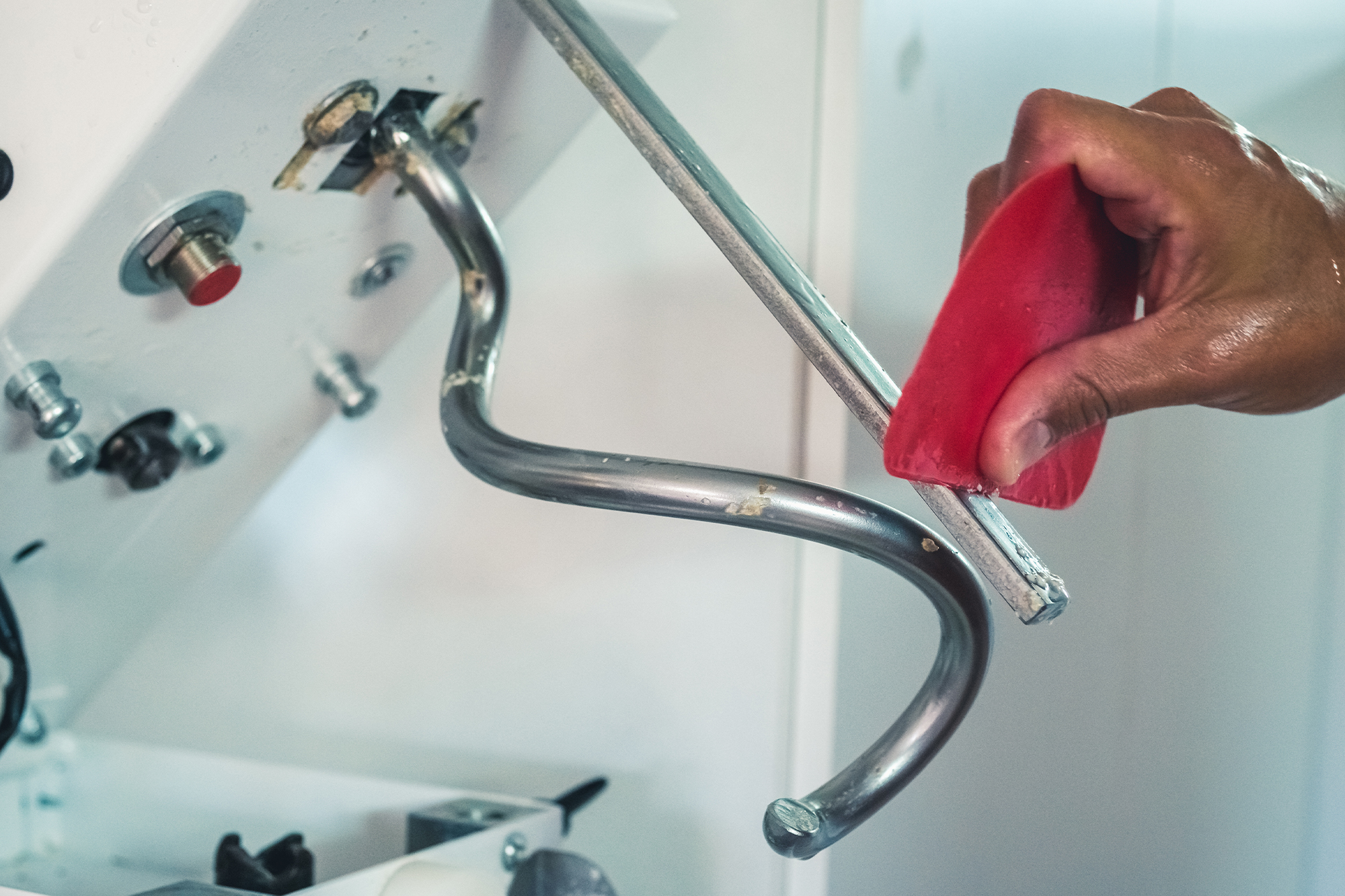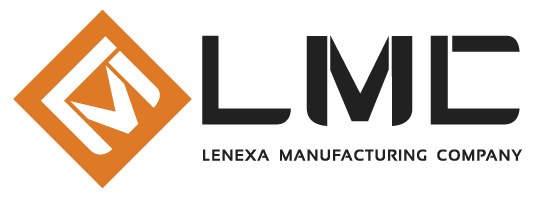
Why is it important to clean and maintain your commercial bakery machinery?
Upgrading your bakery with cutting-edge commercial machinery lets you accelerate your operation and deliver consistent quality.
But just buying an industrial bread slicing machine or choosing the right bun packaging equipment isn’t enough.
That’s because:
- Constantly using your machinery creates wear and tear. This increases the risk of breakage and malfunction, which lead to long periods of unexpected machine downtime.
- The buildup of crumbs and other debris inside the machine creates the perfect breeding ground for bacteria. Allowing this bacterial growth to become a major sanitation issue might even result in the closure of your bakery.
To keep your equipment in top condition, it’s essential to follow a clearly defined cleaning and maintenance plan.
Follow our checklist below to find out how to clean and maintain your commercial bakery machinery.
Before starting your cleaning and maintenance
1) Choose equipment that’s easy to disassemble
When you’re shopping for automated bakery equipment, consider whether a machine will be easy to disassemble and reassemble. Choose one that lets you easily access all parts, and buy the tools you’ll need to do so.
Alternatively, you can take our short bakery equipment quiz to find your perfect new addition in seconds.
2) Turn off and unplug your machine
Disassembling live machinery is extremely dangerous. It’s easy to electrocute yourself, lose a finger or get your clothes caught in the moving parts. Make sure your machine is turned off and unplugged before disassembly.
3) Let your machine cool down
Even after you unplug your machine, it might still be hot from use, particularly on the inside where there’s very little ventilation. Give your machine plenty of time to cool down before disassembling it.
4) Dress for safety
Wear cut-resistant gloves, and secure any loose clothing that could get caught in the machinery.
Even with the correct safety equipment, avoid pressing on the machine’s blades. This could damage them, or lead to serious injury.
5) Find the right tools
Using inappropriate cleaning and maintenance tools can actually cause more damage to your machine. So, you’ll need a brush or paper towels for dry cleaning, and an anti-scratch sponge for wet cleaning.
You should also use a sprayer to apply cleaning fluid. That way, it will be applied evenly, and you reduce the risk of trapping moisture in the machine.
6) Choose suitable chemicals
The cleaning chemicals you use should depend on what materials your machine is made of. Polymers, elastomers, metals, and soft metals are sensitive to different chemicals, and using the wrong ones could cause corrosion.
If you’re not sure what cleaning chemicals are appropriate for your machine, a safe option is to use a pH-neutral detergent.
While performing your cleaning and maintenance
1) Follow the disassembly instructions in your machine’s manual
By following the manual, you can disassemble your machine thoroughly and without damage. That means you can effectively clean every part, and reassemble your machine successfully once you’re finished.
2) Dry clean to remove debris
If you try to wet clean your machinery right away, the soil, crumbs and debris will absorb the liquid. This makes them hard to remove, and encourages bacterial growth. Instead, remove debris using your brush or paper towels.
Some bakers dry clean their equipment using compressed air, dry steam or dry ice. But these only move debris from one place to another without removing it. If you intend to use these, do so as a final detail after removing major debris.
3) Wet clean to remove dirt
Once you’ve removed the debris, spray your cleaning solution onto each part and wipe it with your anti-scratch sponge. Tight areas like knobs, screws, and handles might need extra attention.
Be aware that not all surfaces should be wet cleaned. For example, cloth belts absorb water, which can cause mold to grow in a key food contact area. To avoid this problem, swap absorptive components for non-absorptive ones, such as exchanging a cloth belt for a monolithic belt.
4) Replace rusted or worn parts before they break
Take this opportunity to replace rusted or worn parts. Doing so now lets you achieve a consistent, high-precision slice, and avoid unexpected machine downtime from breakages.
You can stock up on UBE replacement parts today to make sure your machinery always runs at peak performance.
After finishing your cleaning and maintenance
1) Wipe down all parts with warm water
After sanitizing your machine, it’s important to wash away the cleaning chemicals to avoid impacting the taste of your products. Use a separate spray bottle and anti-scratch sponge to wipe down all parts again with warm water. Then, dry them thoroughly before reassembly to prevent moisture retention and bacterial growth.
2) Follow the reassembly instructions in your machine’s manual
Reassemble your machine according to the manual’s instructions. As you do, be sure to tighten all screws.
3) Plug your machine back in and turn it on
Once you’ve reassembled your machine, plug it in and turn it on to make sure it’s working properly.
4) Clean your cleaning tools
As a final step, you also need to clean, inspect and sanitize your cleaning tools to avoid future cross-contamination.
Guarantee high standards of sanitation with a monthly cleaning schedule
For your bakery to maintain high standards of sanitation, we recommend creating a Sanitation Standard Operating Procedure (SSOP). This is a document that sets your benchmark for what is ‘clean’, and gives specific details for how your staff should perform cleaning and maintenance tasks. The above checklist is a great way to start writing your SSOP.
But how often should you clean and maintain your commercial bakery machinery? When it comes to frequency, there are three important questions to consider:
1) What’s your product throughput?
The more products you slice, the more frequently you’ll need to perform your SSOP. As a general rule, if you only slice 50 loaves a day, once a month might be enough. But if you cut 500 loaves a day, consider doing it at least once a week.
2) What types of products do you process?
If you mainly process soft white breads that slice very easily, it’s unlikely your machinery will produce much debris. But if you slice hard artisan breads or flakey pastries, you can expect a lot more.
But the types of bread you process isn’t the only consideration. If your products include egg glazes, or dairy products such as cream, there’s a higher food safety risk. In this case, you should clean your equipment more frequently.
3) Does your machinery have a hygienic design?
A machine with hygienic design has been built to be easily disassembled, cleaned and maintained.
If your machine has a hygienic design, then your standard cleaning and maintenance SSOP should remove the majority of soil and debris. But a machine that doesn’t offer easy access to all parts, or has many cracks, crevices and dead space, needs to be cleaned more often.
The importance of connecting with commercial bakery machinery maintenance technicians
Sticking to an effective monthly cleaning and maintenance schedule is an excellent way to:
- Greatly extend your equipment’s life expectancy.
- Improve energy consumption to reduce utility costs.
- Reduce risk of failures, breakages, and downtime.
- Ensure a secure work environment for your staff.
But not even the most rigorous schedule can truly maximize the efficiency of your equipment. So, it’s important to connect with trusted maintenance technicians to ensure you get the highest possible value from your commercial bakery machinery.
At LMC, our team of expert maintenance technicians specializes in identifying and resolving potential risks long before they affect your production. When you schedule maintenance assistance, our technicians stay by your side for as long as you need. They also provide on-site auditing, servicing, and training of the highest industry standard to accelerate the growth of your bakery.
Schedule your appointment for maintenance assistance today to optimize the performance of your commercial bakery machinery.
